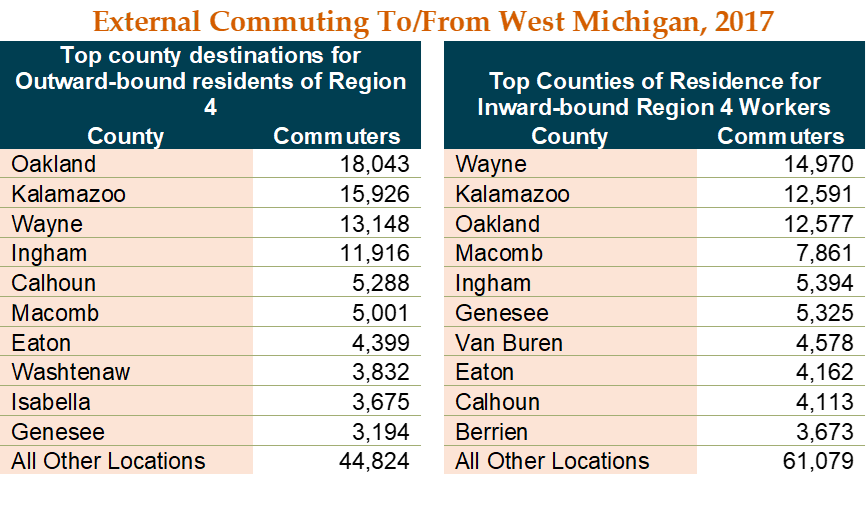Commuting patterns serve as an effective method to identify labor sheds, both at the regional and sub-regional levels, and the availability of information regarding where talent resides compared to where talent works can significantly impact the success of employers’ recruitment efforts.
Data regarding West Michigan’s 2017 commuting patterns were updated on the U.S. Census Bureau’s OnTheMap online tool in August of 2019. These estimates were obtained from employers, covered by unemployment insurance, and from Census data provided by individuals in order to determine commuting patterns at various geographic levels.
Commuting Beyond West Michigan
In 2017 there were 739,080 individuals employed across West Michigan, irrespective of their place of residence. Of this employed population, 602,757 individuals both lived and worked within the region, accounting for 81.6 percent of all employees in West Michigan. Thus, 136,323 West Michigan employees lived beyond the boundaries of the thirteen counties and made a commute into the region for employment in 2017. Conversely, a total of 732,003 individuals were considered residents of West Michigan during the relevant year. Approximately 17.7 percent, or 129,246 residents, were employed beyond the boundaries of the region and made a commute out of West Michigan for work.

Commuting Within West Michigan
Grand Rapids
In 2017 there were 124,651 individuals employed in the City of Grand Rapids, with just under a quarter of the respective population also residing within the city’s boundaries (30,485 residential employees). As such, 75.5 percent of those employed within the city commuted from their place of residence beyond the city’s limits, leaving 94,166 individuals who commuted into Grand Rapids for work in 2017. The city’s 2017 residential population of 91,431 employed individuals consisted of 33.3 percent who remained within the city for work, while almost 67 percent of those living in Grand Rapids were employed somewhere outside of the city. The top destinations for commuters who lived in Grand Rapids at this time were Wyoming, Kentwood, Walker, and Forest Hills.
Holland
According to the U.S. Census Bureau, there were 30,241 individuals employed in the City of Holland in 2017. The city’s workers predominately lived outside of the city, with over three-quarters (84.3 percent) of the employed population commuting into the city for work. The city’s residential population consisted of 16,608 employed individuals, yet only 4,758 residents (28.6 percent) remained within the city’s limits during their commute to work. Thus, 71.4 percent of those living in Holland travelled beyond the boundaries of the city during their commute to work in 2017. The top destinations for residents commuting out of Holland were Grand Rapids, Wyoming, Zeeland, Kentwood, and Walker.
Muskegon
Compared to Grand Rapids or Holland, the City of Muskegon saw the lowest proportion of its employed population also living in the city during 2017 — accounting for 3,161 residents (22.5 percent) of the city’s 23,053 total employees. Of the 14,047 individuals who lived in the City of Muskegon during 2017, just 13.7 percent remained within the city for employment. Therefore, 77.5 percent of Muskegon residents (10,886 individuals) were employed outside of the city and made a regular commute beyond the city’s limits for work. The top destinations for these commuters were Norton Shores, Roosevelt Park, Grand Rapids, and Grand Haven.
Future Data Topics
Have you been enjoying these “Data Points” blogs? Are you interested in other data? Let us know what topics you’d like to know more about on our Twitter @WMTalent2025! We’d like to crunch some numbers that you’re interested in.


